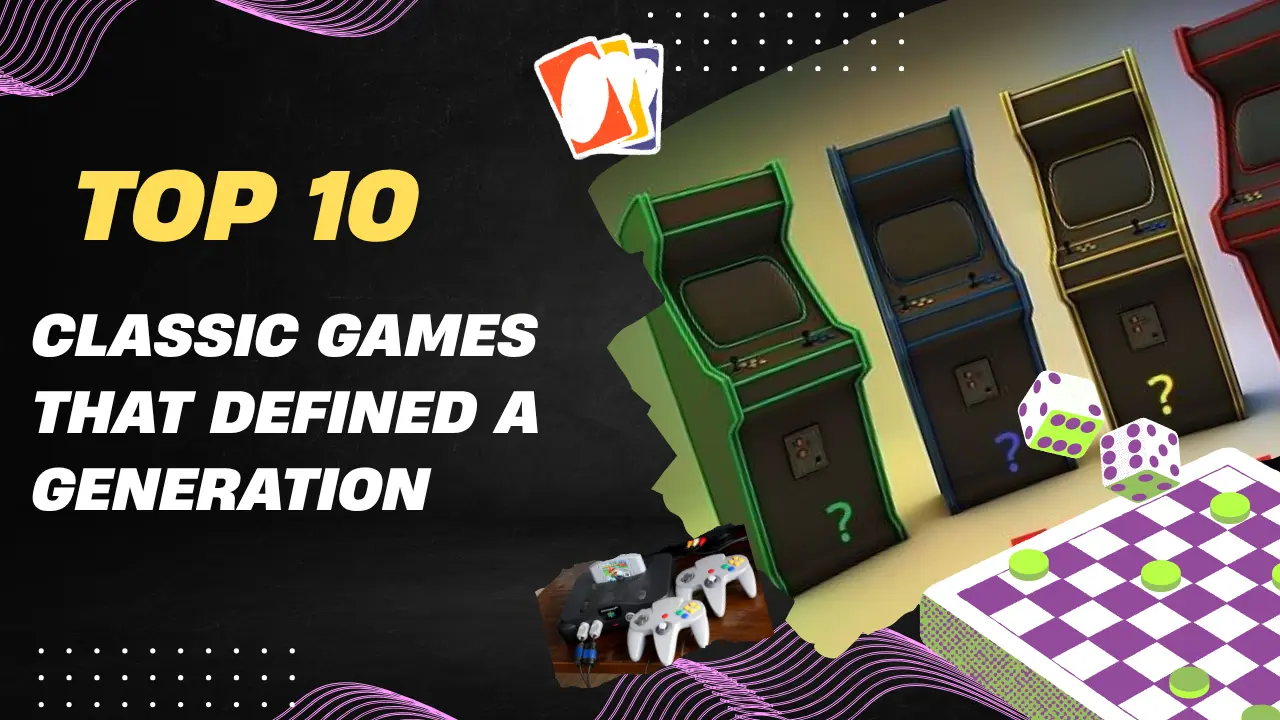Classic games have spread an unforgettable memory across millions of players throughout the world, from the pixilated screens of the arcade in the 1980s to the golden years of console gaming in the 1990s. These games did not merely provide entertainment; they defined an entire generation and created cultural icons. They established the framework for the gaming industry as we know it today. In the article are 10 legendary classic games that shaped the whole gaming community, all of which are still fondly remembered in nostalgia.
1. Super Mario Bros. (1985) – NES
A list of classic games could not possibly be complete without Super Mario Bros. In 1985, Nintendo released the game, which introduced plat forming into the world of Mario and Luigi in the Mushroom Kingdom.
Why It Defined a Generation:
- Promoted the side-scrolling platform genre.
- Revived the gaming industry after the 1983 crash.
- Timeline-level design, music, and characters became iconic.
Super Mario Bros. is referenced and paid homage to by gamers, old and new; it still gets multiple re-releases to this day.
2. Tetris (1984) – Multiple Platforms
Few puzzle games have achieved the recognition that Tetris, designed by Russian developer Alexey Pajitnov, has rightfully attained.
Why It Defined a Generation:
- The nice game play addicted kids as well as adults.
- It came packaged in the original Game Boy, making it something that went into the entire world.
- The falling blocks and the music became popular right away.
Tetris has told us that games don’t need real stunning graphics to remain forever engraved in your memory.
3. The Legend of Zelda (1986) – NES
This title brought to revolutionize the world, at that time, with its action, adventure, and puzzle-solving for an open-world game.
Why It Defined a Generation:
- It introduced battery-backed saving to consoles.
- It encouraged exploration and thinking, not action.
- Created one of gaming’s most legendary franchises.
Hero of the game Link became the symbol for generations of gamers in their bravery and adventure.
4. Pac-Man (1980) – Arcade
With the unmistakable bright yellow color and dot-munching act, Pac-Man reigned supreme to become a household name and pop culture icon in the early 80s. Indications of Generational Definition:
- Attracted both casual players and hardcore players.
- It is one of the first games to have a character-based mascot.
- It helped its arcade success to expand the gaming audience reach to the mainstream. Pac-Man was so much more than a game: toys, cartoon shows, even records bore his stamp.
5. Street Fighter II (1991) – Arcade/SNES
Street Fighter II not only defined fighting games but also made them become what they are today: the modern fighting game genre.
Why It Defined a Generation:
- Competitive head-to-head fights in arcade pinball.
- Combo-based game mechanics that still prevail today.
- Gave birth to the names of popular characters like Ryu, Chun-Li, and Ken.
Street Fighter II once fired the arcade battles that served as the tinder for eSports before the word was coined.
6. Doom (1993) -PC
This was the game that really made a hype about being a first-person shooter, crossing the frontiers of PC gaming.
Why It Defined a Generation:
- One of the earliest games to support modding.
- Created fast-forward 3-D shooting with multiplayer deathmatches.
- It has spawned such an enduring genre.
Doom’s action-packed play of blood and gore, combined with technological revolution in the game, left an imprint that the gaming industry cannot rub off.
7. Sonic the Hedgehog (1991) – Sega Genesis
Sonic addressed the rivalry with Mario, a quintessential ’90s gaming icon, trying to capture the speed of life with a fast blue mascot by Sega.
Why It Defined a Generation:
- Provided very fast-paced gameplay and bright graphics.
- Helped Sega gain recognition in the console wars against Nintendo.
- Developed into a huge fan base and subsequent franchise.
Ah, Sonic: not just a game but the very essence of every ’90s kid.
8. Final Fantasy VII (1997) – PlayStation
Final Fantasy VII was the first role-playing game to delve into emotional cinematic extremes.
Why It Defined a Generation:
- Brought a high degree of storytelling and characterization into mainstream gaming.
- Well, it sold systems for the original PlayStation.
- Introduced millions of players to JRPGs.
With its famous characters and memorable story, FFVII turned the corner in RPG history.
9. Pokémon Red and Blue (1996) – Game Boy
Pokémon Red and Blue were two versions for the Game Boy released in 1996 and were responsible for the birth of a multi-billion dollar franchise; these games turned into global obsessions.
What Really Made It Defining for a Generation?
- Social play through trading and battling was encouraged without any fuss.
- Engaging and Interactive portable gaming.
- Introduced more than 150 creatures that are still much-loved today.
For many, Pokémon was not just a game but a way of life.
10. The Oregon Trail (1985) – Apple II/PC
This was a fun educational game, a rarity among most of the items on this list.
Why It Defined a Generation:
- Taught millions of schoolchildren to play computer games.
- Combined survival strategy and historical education.
- You have died of dysentery” became an inside joke of the time.
For many, this was their first experience with computer gaming in school in the USA.
The Legacy of Old Games
What made them legendary was not just the gameplay or graphics, but the impact on these titles:
- Definitely set standards for the entire
- Introduced characters that still remain important for so many
- Defined childhood and introduced millions to games
Classic games taught us timeless lessons related to creativity, challenge, and storytelling. They established the foundation of the innovation of modern gaming and continue to inspire remakes, sequels, and spiritual successors.
________________________________________
Conclusion
The above list of 10 classic games is, however, beyond nostalgia. They have become cultural pillars anchoring the history of gaming: how it has changed the way games were played, marketed, and remembered. Be it dodging ghosts in Pac-Man, catching creatures in Pokémon, or having an adventure through Hyrule in Zelda-All these have had lifelong impacts.
So much hyper-realistic graphics and online multiplayer experience these days, but it is important to remember where it all began. Simple as these classics may look at present, they were revolutionary for their time, and they remain popular for a good reason.
So, dust off your old game cartridges, fire up an emulator, or get a re-release because once you’ve played them, the classics are the sorts that will never go out of style.

